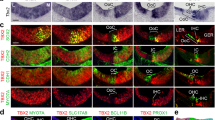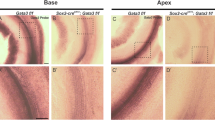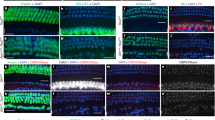Abstract
For mammalian cochlear hair cells, fate determination is normally completed by birth. We report here that overexpression of Math1, a mouse homolog of the Drosophila gene atonal, in postnatal rat cochlear explant cultures resulted in extra hair cells. Surprisingly, we found that the source of the ectopic hair cells was columnar epithelial cells located outside the sensory epithelium in the greater epithelial ridge, which normally give rise to inner sulcus cells. Moreover, Math1 expression also facilitated conversion of postnatal utricular supporting cells into hair cells. Thus Math1 was sufficient for the production of hair cells in the ear, and immature postnatal mammalian inner ears retained the competence to generate new hair cells.
This is a preview of subscription content, access via your institution
Access options
Subscribe to this journal
Receive 12 print issues and online access
$209.00 per year
only $17.42 per issue
Buy this article
- Purchase on Springer Link
- Instant access to full article PDF
Prices may be subject to local taxes which are calculated during checkout






Similar content being viewed by others
References
Van de Water, T. R. in Development of Auditory and Vestibular Systems (ed. Romand, R.) 337–374 (Academic, New York, 1983).
Ruben, R. J. Development of the inner ear of the mouse: A radioautographic study of terminal mitosis. Acta Otolaryngol. Suppl. 220, 1–44 (1967).
Balak, K. J., Corwin, J. T. & Jones, J. E. Regenerated hair cells can originate from supporting cell progeny: evidence from phototoxicity and laser ablation experiments in the lateral line system. J. Neurosci. 10, 2502–2512 (1990).
Corwin, J. & Cotanche, D. Regeneration of sensory hair cells after acoustic trauma. Science 240, 1772–1774 (1988).
Ryals, B. M. & Rubel, E. W. Hair cell regeneration after acoustic trauma in adult Coturnix quail. Science 240, 1774–1776 (1988).
Fekete, D. M. Cell fate specification in the inner ear. Curr. Opin. Neurobiol. 6, 533–541 (1996).
Li, L. & Forge, A. Morphological evidence for supporting cell to hair cell conversion in the mammalian utricular macula. Int. J. Dev. Neurosci. 15, 433–446 (1997).
Fekete, D. M., Muthukumar, S. & Karagogeos, D. Hair cells and supporting cells share a common progenitor in the avian inner ear. J. Neurosci. 18, 7811–7821 (1998).
Lim, J. & Rueda, J. in Development of Auditory and Vestibular Systems. (ed. Romand, R.) 33–58 (Elsevier, New York, 1992).
Fekete, D. M. Development of the vertebrate ear: insights from knockouts and mutants. Trends Neurosci. 22, 263–269 (1999).
Lowenheim, H. et al. Gene disruption of p27(Kip1) allows cell proliferation in the postnatal and adult organ of corti. Proc. Natl. Acad. Sci. USA 96, 4084–4088 (1999).
Chen, P. & Segil, N. p27(Kip1) links cell proliferation to morphogenesis in the developing organ of Corti. Development 126, 1581–1590 (1999).
Akazawa, C., Ishibashi, M., Shimizu, C., Naknish, S. & Kageyama, R. A mammalian helix-loop-helix factor structurally related to the product of Drosophila proneural gene atonal is a positive transcriptional regulator expressed in the developing nervous system. J. Biol. Chem. 270, 8730–8738 (1995).
Bermingham, N. A. et al. Math1: an essential gene for the generation of inner ear hair cells. Science 284, 1837–1841 (1999).
Zheng, J. L. & Gao, W.-Q. Differential damage to auditory neurons and hair cells by ototoxins and neuroprotection by specific neurotrophins in rat cochlear organotypic cultures. Eur. J. Neurosci. 8, 1897–1905 (1996).
Zheng, J. L. & Gao, W.-Q. Concanavalin A protects hair cells against gentamicin ototoxicity in rat cochlear explant cultures. J. Neurobiol. 39, 29–40 (1999).
Hasson, T., Heintzelman, M. B., Santos-Sacchi, J., Corey, D. P. & Mooseker, M. S. Expression in cochlea and retina of myosin VIIa, the gene product defective in Usher syndrome type 1B. Proc. Natl. Acad. Sci. USA 92, 9815–9819 (1995).
Murone, M., Rosenthal, A. & de Sauvage, F. J. Sonic hedgehog signaling by the patched-smoothened receptor complex. Curr. Biol. 28, 76–84 (1999).
Zheng, J. L. & Gao, W.-Q. Analysis of rat vestibular hair cell development and regeneration using calretinin as an early marker. J. Neurosci. 17, 8270–8282 (1997).
Gibson, U. E., Heid, C. A. & Williams, P. M. A novel method for real time quantitative RT-PCR. Genome Res. 6, 995–1001 (1996).
Sundaresan, S., Roberts, P. E., King, K. L., Sliwkowski, M. X. & Mather, J. P. Biological response to ErbB ligands in nontransformed cell lines correlates with a specific pattern of receptor expression. Endocrinology 139, 4756–4764 (1998).
Sobkowicz, H. M., Bereman, B. & Rose, J. E. Organotypic development of the organ of Corti in culture. J. Neurocytol. 4, 543–572 (1975).
Erkman, L. et al. Role of transcription factors Brn-3.1 and Brn-3.2 in auditory and visual system development. Nature 381, 603–606 (1996).
Xiang, M. et al. Essential role of POU-domain factor Brn-3c in auditory and vestibular hair cell development. Proc. Natl. Acad. Sci. USA 94, 9445–9450 (1997).
Xiang, M., Gao, W.-Q., Hasson, T. & Shin, J. J. Requirement for Brn-3c in maturation and survival, but not in fate determination of inner ear hair cells. Development 125, 3935–3946 (1998).
Zheng, J. L., Helbig, C. & Gao, W.-Q. Induction of cell proliferation by fibroblast and insulin-like growth factors in pure rat inner ear epithelial cell cultures. J. Neurosci. 17, 216–226 (1997).
Corwin, J. T. et al. Growth factors as potential drugs for the sensory epithelia of the ear. Ciba Found. Symp. 196, 167–182; discussion 182–187 (1996).
Lewis, A. K., Frantz, G. D., Carpenter, D. A., de Sauvage, F. J. & Gao, W.-Q. Distinct expression patterns of notch family receptors and ligands during development of the mammalian inner ear. Mech. Dev. 78, 159–163 (1998).
Haddon, C., Jiang, Y. J., Smithers, L. & Lewis, J. Delta-Notch signalling and the patterning of sensory cell differentiation in the zebrafish ear: evidence from the mind bomb mutant. Development 125, 4637–4644 (1998).
Lanford, P. J. et al. Notch signalling pathway mediates hair cell development in mammalian cochlea. Nat. Genet. 21, 289–292 (1999).
Stone, J. S. & Rubel, E. W. Delta1 expression during avian hair cell regeneration. Development 126, 961–973 (1999).
Kageyama, R. & Nakanishi, S. Helix-loop-helix factor in growth and differentiation of vertebrate nervous system. Curr. Opin. Genet. Dev. 7, 659–665 (1997).
Jarman, A., Grau, Y., Jan, L. & Jan, Y. Atonal is a proneural gene that directs chordotonal organ formation in the Drosophila peripheral nervous system. Cell 73, 1307–1321 (1993).
Kim, P., Helms, A., Johnson, J. & Zimmerman, K. XATH-1, a vertebrate homolog of Drosophila atonal, induces aneuronal differentiation within ectodermal progenitors. Dev. Biol. 187, 1–12 (1997).
Kelley, M. W., Xu, X. M., Wagner, M. A., Warchol, M. E. & Corwin, J. T. The developing organ of Corti contains retinoic acid and forms supernumerary hair cells in response to exogenous retinoic acid in culture. Development 119, 1041–1053 (1993).
Abdouh, A., Despres, G. & Romand, R. Hair cell overproduction in the developing mammalian cochlea in culture. Neuroreport 5, 33–36 (1993).
Cotanche, D. A. & Lee, K. H. Regeneration of hair cells in the vestibulocochlear system of birds and mammals. Curr. Opin. Neurobiol. 4, 509–514 (1994).
Corwin, J. T. & Oberholtzer, J. C. Fish n' chicks: model recipes for hair-cell regeneration? Neuron 19, 951–954 (1997).
Stone, J. S., Oesterle, E. C. & Rubel, E. W. Recent insights into regeneration of auditory and vestibular hair cells. Curr. Opin. Neurol. 11, 17–24 (1998).
Warchol, M. E., Lambert, P. R., Goldstein, B. J., Forge, A. & Corwin, J. T. Regenerative proliferation in inner ear sensory epithelia from adult guinea pigs and humans. Science 259, 1619–1622 (1993).
Kuntz, A. L. & Oesterle, E. C. Transforming growth factor alpha with insulin stimulates cell proliferation in vivo in adult rat vestibular sensory epithelium. J. Comp. Neurol. 399, 413–423 (1998).
Forge, A., Li, L. & Nevill, G. Hair cell recovery in the vestibular sensory epithelia of mature guinea pigs. J. Comp. Neurol. 397, 69–88 (1998).
Rubel, E. W., Dew, L. A. & Roberson, D. W. Mammalian vestibular hair cell regeneration. Science 267, 701–707 (1995).
Warchol, M. E., Lambert, P. R., Goldstein, B. J., Forge, A. & Corwin, J. T. Response to: Mammalian vestibular hair cell regeneration. Science 267, 704–706 (1995).
Zheng, J. L., Keller, G. & Gao, W.-Q. Immunocytochemical and morphological evidence for intracellular self-repair as an important contributor to mammalian hair cell recovery. J. Neurosci. 19, 2161–2170 (1999).
Acknowledgements
We thank R. Kageyama for providing the Math1 cDNA (pCMV-Math1 plasmid) and M. Murone for providing the pRK5-EGFP plasmid for reconstruction of the pRK5-Math1-EGFP plasmid. We also thank T. Hasson for the anti-myosin VIIa antibody, M. Xiang for the pRK5SK-mBrn3c plasmid, A. Rosenthal and H. Sobkowicz for discussions, J. Shou for reading the manuscript, L. Rangell and G. Keller for electron microscopy, H. Aaron for confocal microscopy and A. Bruce for preparing the figures.
Author information
Authors and Affiliations
Corresponding author
Rights and permissions
About this article
Cite this article
Zheng, J., Gao, WQ. Overexpression of Math1 induces robust production of extra hair cells in postnatal rat inner ears. Nat Neurosci 3, 580–586 (2000). https://doi.org/10.1038/75753
Received:
Accepted:
Issue Date:
DOI: https://doi.org/10.1038/75753
This article is cited by
-
The proper timing of Atoh1 expression is pivotal for hair cell subtype differentiation and the establishment of inner ear function
Cellular and Molecular Life Sciences (2023)
-
GFI1 regulates hair cell differentiation by acting as an off-DNA transcriptional co-activator of ATOH1, and a DNA-binding repressor
Scientific Reports (2022)
-
The interaction of Notch and Wnt signaling pathways in vertebrate regeneration
Cell Regeneration (2021)
-
Differential regulation of mammalian and avian ATOH1 by E2F1 and its implication for hair cell regeneration in the inner ear
Scientific Reports (2021)
-
Tsukushi is essential for the formation of the posterior semicircular canal that detects gait performance
Journal of Cell Communication and Signaling (2021)



